This step-by-step written guide and video tutorial walks you through the entire process of planning for Milky Way, star trails, and night sky photography. Guaranteed great photos!
Learn how to use the best websites, apps, and computer programs, essential to taking beautiful photos of the stars, milky way & night sky.
Table of Contents
Video I: Moon Phase, Dark Skies & Weather (Teaches Steps 1 – 3)
Step 1: Calculate the Moon Phase
Step 2: Find Dark Skies
Step 3: Find Clear Skies – Predicting the Weather
Video II: The Photographer’s Ephemeris & Google Earth (Teaches Steps 4-5)
Step 4: Learn to Use The Photographers Ephemeris ( TPE )
Step 5: Learn to Use Google Earth / Maps
Video III: Locate the Milky Way – Stellarium (Teaches Step 6)
Step 6: Locate the Milky Way w/ Stellarium
Video I: Moon Phase, Dark Skies & Weather
Step 1: Calculate the Moon Phase
Click Here for Star Date Moon Phase Calculator
Our Moon rotates around our Sun approximately once every 27.3 days. This means we will see approximately the same views of the Moon once each 27.3 days.
During the New Moon, when the sun lies directly between planet Earth and the sun, is the best time to photograph the Milky Way. Due to the New Moon’s location between us and the Sun, there is no light cast on the side of the moon which we can see from Earth. In turn the Earth will receive no Moon light on these nights for a short period of time.
That being said, the night of the New Moon will provide the longest and darkest hours to photograph the Milky Way. There are also 5-6 nights on either side of the night of the New Moon which will also work great for photographing the Milky Way.
During these nights there will be no Moon visible in the sky for a minimum of 1-2 hours a night and a maximum of approximately 10 hours a night. These 10-12 days fall directly before, directly after, and include the night of the New Moon.
Star trails and Northern Lights photography are much more forgiving. You can capture star trails or Northern Lights photos with, or without, the Moon visible in the sky. Both situations will yield different and unique results.
Step 2: Find Dark Skies
Blue Marble Light Pollution Map works very well for this. Black areas on the map are great for shooting the night sky, while white areas on the map are light polluted and should be avoided.
Step 3: Find Clear Skies – Predicting the Weather
Without clear skies it will be impossible to get a clean view of the Milky Way, stars, or Northern Lights. This doesn’t mean there can’t be a few clouds. Sometimes clouds here and there add to the “interestingness” of the photo, but complete cloud cover won’t allow you to see the night sky.
Outside the USA: I use and recommend MeteoStar Weather Website.
Inside the USA: I use and recommend NOAA ( National Oceanic & Atmospheric Administration ). It provides in depth weather forecasting data for all of the United States.
Here is a great way to go about finding cloud cover percentages using NOAA. I also show you how to do this in Video I – Moon Phase, Dark Skies and Weather, above.
- Visit http://www.noaa.gov/
- Type in a city and state near where you would like to shoot. It just has to be close. We can re-adjust in the next step!
- Once you search for your city and state, a new page will come up.
- Using the map on the new page, zoom out as required, then, click the exact location where you would like to see the weather forecast. Click Here to see where I’ve done this for Mount Rainier, Washington.
- Now, scroll down the same page until you see the Hourly Weather Graph on the right hand side. Click the Hourly Weather Graph graphic.
- Now you can decide the date, time, weather, and precipitation elements which you would like to view. Use the checkboxes to turn them on and off.
- Using the Sky Cover Percentage ( % ) you will be able to predict how many clouds will be present at any specific time! Ideally aim for 0-20% cloud cover. 21-60% is also acceptable. Shooting with 80-90% cloud cover is possible, but will not yield many great shots.
Video II: Photographer’s Ephemeris & Google Earth
Step 4: Learn to Use The Photographers Ephemeris ( TPE )
Get TPE For: Desktop | iPhone | Android
The Photographer’s Ephemeris is a map-centric sun and moon calculator: see how the light will fall on the land, day or night, for any location on earth. TPE also provides precise sunrise, sunset, and twilight times as well as moon rise and moonset times.
Referencing the Example 1: Screen Shot – The Photographer’s Ephemeris ( below ) I was able to find a suitable Milky Way photography night at Mount Rainier National Park for Wednesday, June 17th, 2015.
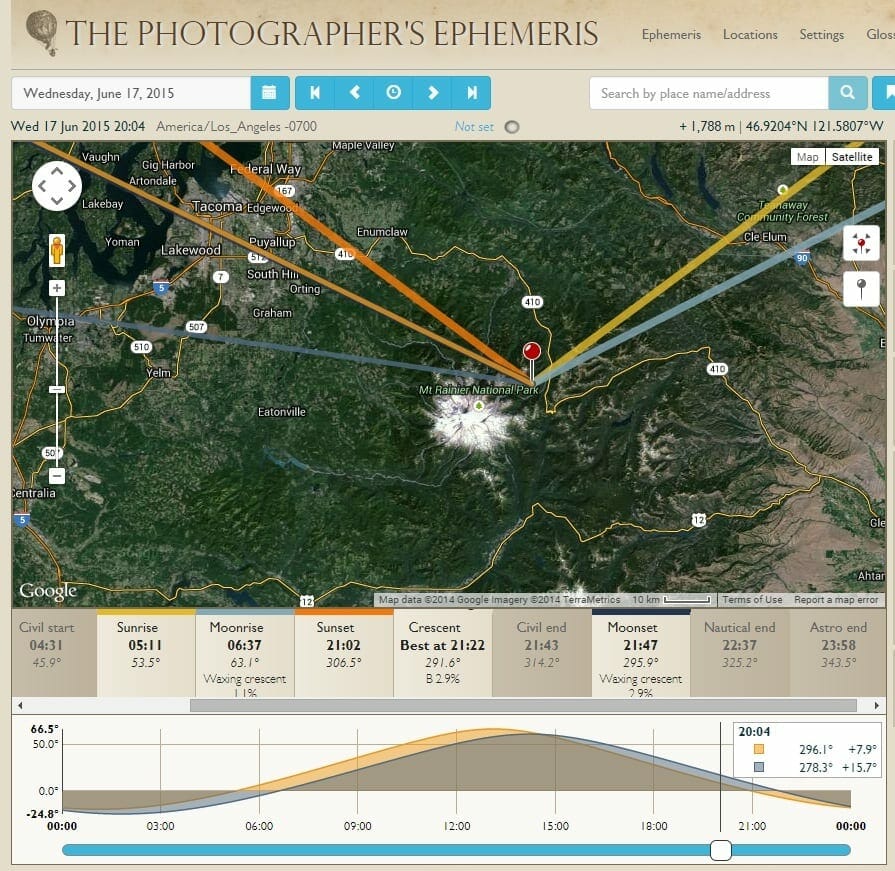 |
| Example 1: Screen Shot – The Photographer’s Ephemeris |
To ensure maximum length of darkness, I selected a night where the Moon set early in the night, preferably right before or right after sunset. In Example 1: Screen Shot – The Photographer’s Ephemeris ( above ), moonset is at 21:47 and sunset is at 21:02.
It was also crucial to ensure that the moon did not rise too early in the morning. The moonrise on this particular morning ( now June 18th ) is 07:36 leaving plenty of time to shoot.
As noted before, to ensure darkest skies, it’s always best to shoot a minimum of 1-2 hours before the rise or after the set of a large celestial body ( Sun & Moon ). If the sun sets at 21:02, and the moon rises at 02:00 the next morning, this would not give much time to shoot in pure darkness.
With the current conditions as denoted on the Example 1: Screen Shot – The Photographer’s Ephemeris ( above ), the sky will be very dark by 23:58. This is known as the end of Astronomical Twilight. Astronomical Twilight is when the sun lies 12-18 degrees below the horizon and is the last time you can actually “see” any remains of sunlight in the sky.
You can still get some great shots during Civil & Nautical Twilight, but the skies won’t be as dark, this means you won’t see as many stars.
During Civil Twilight the sun lies 0 – 6 degrees below the horizon, and during Nautical Twilight the Sun lies 6-12 degrees below the horizon. The twilight conditions noted above happen twice each day; before sunrise and after sunset.
In far Northern and Southern latitudes ( above and below 60 degrees North and South respectively ), the sun doesn’t always set or rise during certain times of year. When traveling to these extreme latitudes it’s especially important to plan for your photography trips!
Step 5: Learn to Use Google Earth / Maps
Get Google Earth For: Desktop | iPhone | Android
Get Google Maps For: Desktop | iPhone | Android
Google Earth is my preferred way to plan for any photography trip or shoot. Using Google Earth, you can place yourself into any landscape on this planet and see what the topography looks like around you.
It’s also possible to turn on geotagged pictures which others have taken. These pictures will show up on the Google Earth overlay, allowing you to see what the surrounding landscapes look like. Out of all the tools on this page, Google Maps / Google Earth is where I spend the most time.
I don’t necessarily look at these pictures to see great landscape photos, but to get an idea of the geography of the location, and what possibilities exist off the beaten path. Are there trees, or great views, steep cliffs, or easily accessible vistas? Using these photos you can piece together some knowledge that you wouldn’t have had otherwise.
Prior to arriving at a new location, any extra information is better than nothing at all. Time after time, I’ve been able to find and research locations I didn’t know existed by spending a few hours exploring Google Earth.
Next, you can zoom in even further to get an idea of what it would look like if you were actually standing there with your camera in hand, ready to shoot. This close up view can be seen in Example 2: Screen Shot, Google Earth – Close Up View ( below ).
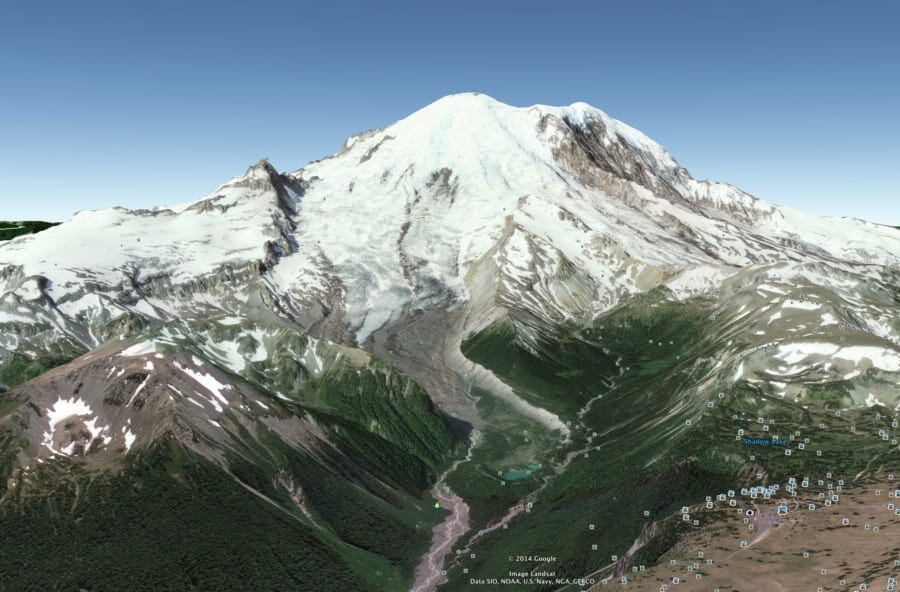 |
| Example 2: Screen Shot, Google Earth – Close Up View |
One of the coolest features of Google Earth allows you to see the scene change over time, on any given date. You can see the sun set, the Moon rise & the Milky Way and stars move through the sky.
Although not perfect, the lighting situations seen in Example 3: Screen Shot, Google Earth – Dynamic View ( below ) can provide great information of what your location may actually look like during any time of day or night.
The views seen in Examples 1 – 3 come from Mount Rainier National Park in Washington State. In the next chapter, we will go into even more detail on how to plan for a shoot from another one of my favorite night sky locations in Washington State.
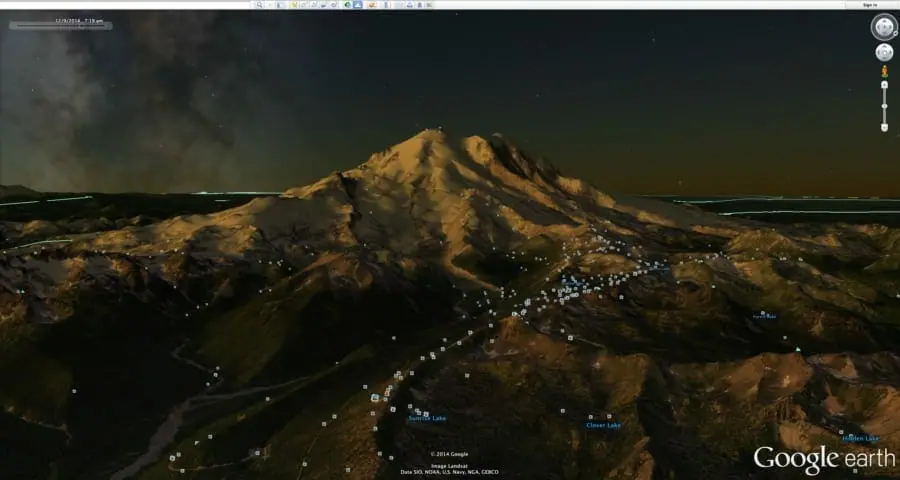 |
| Example 3: Screen Shot, Google Earth – Dynamic View |
Video III: Locate the Milky Way – Stellarium
Step 6: Locate the Milky Way w/ Stellarium
Get Stellarium For: Desktop | iPhone | Android
In short, Stellarium allows you to see exactly where the Milky Way will be in the sky and at what time. It is a free planetarium for your computer. It shows a realistic sky in 3D, just like what you see with the naked eye, binoculars or a telescope. This is perfect for visualizing and planning precise and effective night sky photo shoots.
Let’s return to the location from Example 1 above, at Mount Rainier National Park, and view it in Stellarium.
It’s nearing 03:00 in the morning on June 18th and the Milky Way is bright in the sky. Using Stellarium it’s possible to predict which direction it will show up in the night sky.
Using different fields of view gives me an idea of where the Milky Way will be when showing up at any given location. Referencing Example 4: Screen Shot, Stellarium – 90 Degree + Field of View ( below ) you can see a the Milky Way and foreground with a fairly wide field of view.
This field of view is great for seeing how the Milky Way will be seen during certain times throughout the night and how it will move across the sky over a given period of time. Reference the videos above for a more in depth look.
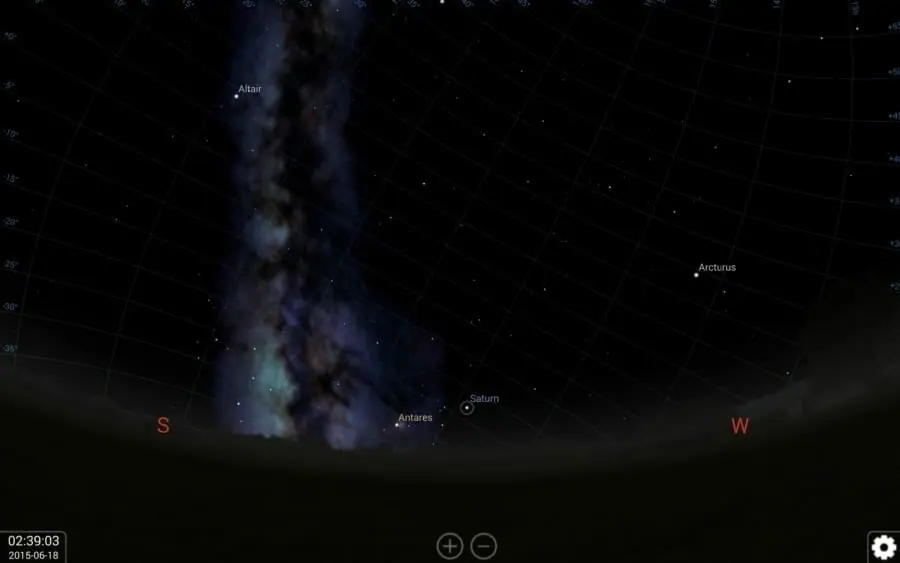 |
| Example 4: Screen Shot, Stellarium – 90 Degree + Field of View |
The Example 5: Screen Shot, Stellarium – 360 Degree Field of View ( below ) allows us to see in all directions at the same time. This is great for planning panoramic photos of the Milky Way or seeing how the planet Earth moves as a whole; with respect to the Milky Way, sky, and stars.
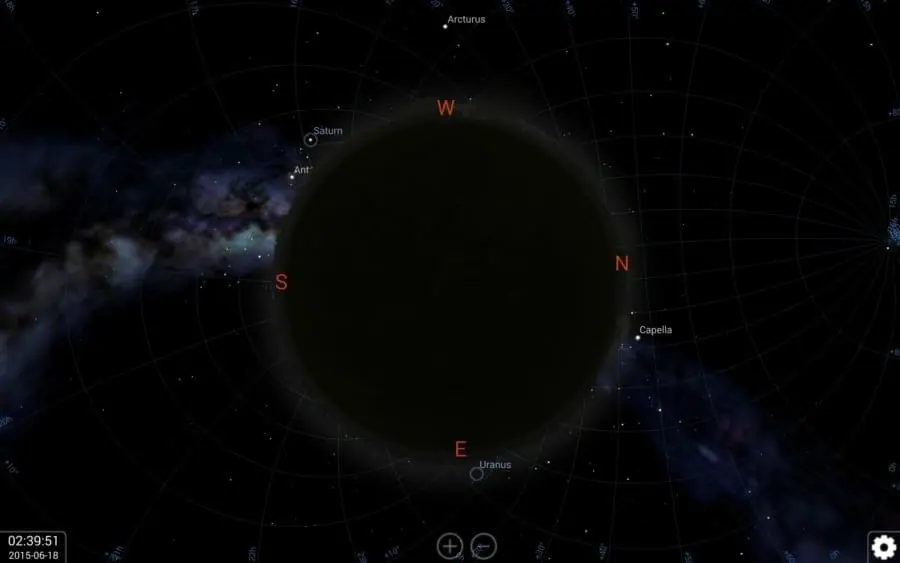 |
| Example 5: Screen Shot, Stellarium – 360 Degree Field of View |
Additional Planning Apps
PhotoPills: If you want one amazing app that does it all for photography, THIS IS IT! Click on the link above for full functionality, there is a lot of it, packaged in a really nice & user friendly app. Get PhotoPills For: iPhone Only
Star Walk is another great and intuitive program that allows you to plan for your shoot. Using Star Walk on your tablet, or mobile device, it is easy to see what the night sky will look like at a given time and place. Get Star Walk For: iPhone | Android
Free Night Photography Tips & Tutorials
Now that you’ve learned how to scout and plan for your photo shoots, it’s essential to learn the best camera settings, equipment, and photo editing techniques using the following free tutorials and step-by-step guides:
Milky Way & Star Photography Tutorial
Northern Lights & Aurora Photography Tutorial
Star Trails Photography Tutorial